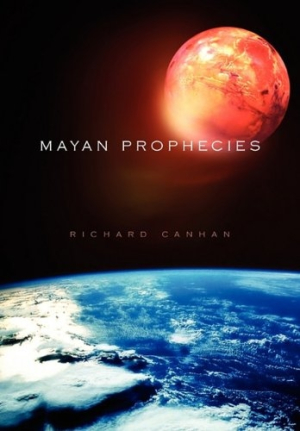Mayan Prophecies
“Anyone that gets washed down river, dressed in rags and carrying that sword, has got to have a remarkable story, and I want to hear it.” So quips the man who saves the hero of Mayan Prophecies from drowning. It is with such teasing promise that author Richard Canhan hopes to draw readers into his cautionary tale of global warming, time travel, and end-of-the-world prophecies.
The second chapter, however, might make those readers groan and close the book, as it brings up the old saw about super-beings from beyond the stars seeding Earth with a select race of master builders. Fortunately, Canhan spends but a few sparse pages on this subplot before getting back to his characters and their story, one that, as his hero Austin Jones describes, is about the “ordeal of finding oneself 500 years in the future and not knowing how or why it happened.”
Both the author and the principal character are Australian—Jones a Harvard-educated mining engineer, Canhan a former soldier turned writer. The novel is set in Australia, and most of it takes place in the early twenty-sixth century. There is a touch of the post-apocalyptic Road Warrior and Book of Eli to the story, although Canhan’s characters are, for the most part, enlightened and benign survivors, which should come as a refreshing change for those familiar with the genre.
The little community into which Austin Jones tumbles becomes galvanized by the hero, who sees the system of time portal tunnels running beneath their enclave as more than just some Alice in Wonderland rabbit holes. As he tells the villagers in his new home: “for some unknown reason, to coin a phrase, we are the chosen ones. We have been given the opportunity and the tools to perform some great tasks for the good of mankind, and we believe one of those tasks is to attempt to change the way the world thinks about global warming and hopefully save the planet from and for mankind.”
Jones, like the author, means well and intends to do good. The story is a little preachy, but Canhan can be forgiven much of that as his intentions are honest and laudable. In the best traditions of science fiction, Canhan is trying to show how bad the future could be if people in the present do nothing to change it.
Though a solid character, Jones is fairly uninspiring, and could grab the reader if Canhan had given him more depth. The same can be said of his loyal follower, Steve (the man who pulled him from the river in the opening chapter), and Steve’s “absolute goddess” of a sister, Darcy, who quite predictably and far too easily becomes Jones’s lover.
There is no real identifiable villain here, and the only tension in the novel comes from wondering when and how—not if—Jones and company will go about their mission to try to save the planet and its inhabitants from themselves. The space travelers do not reappear in the book until the very end, when readers “learn” that they come from Nay-am—which, as most readers will have realized very early on, is “Mayan” spelled backwards.
At 145 pages, Mayan Prophecies is a neat little tale, a quick and easy read with a solid moral. It is interesting and at least mildly entertaining. Canhan is new to the writing game and his heart and conscience are in the right place.
Reviewed by
Mark McLaughlin
Disclosure: This article is not an endorsement, but a review. The publisher of this book provided free copies of the book and paid a small fee to have their book reviewed by a professional reviewer. Foreword Reviews and Clarion Reviews make no guarantee that the publisher will receive a positive review. Foreword Magazine, Inc. is disclosing this in accordance with the Federal Trade Commission’s 16 CFR, Part 255.

